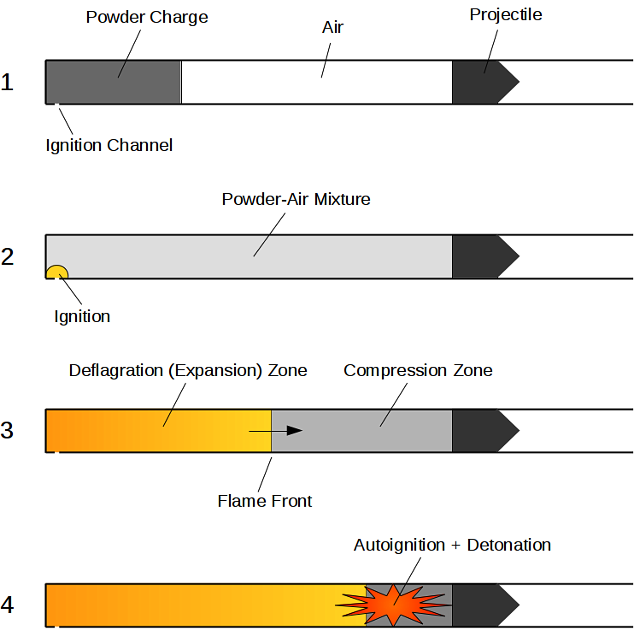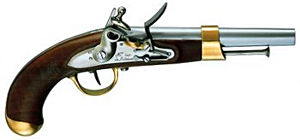
The Short-Started Ball
Much has been speculated about the observed fact that a short-started ball occasionally results in a barrel bulge or even a barrel burst. However, I haven't found a satisfactory explanation for this phenomenon in the literature up to now. I, too, am not able to present hard facts. Nevertheless, I believe I can make an educated guess about what happens inside a gun barrel when there is a sufficiently large air gap between powder charge and projectile. The picture shown below describes, in simplified form, the four stages of the proposed mechanism.

|
Detonation Caused by Short-Started Ball
Let us assume we initially have the powder charge located near the breech plug and a
sufficiently large air gap between powder and projectile (1). The exploding ignition cap
sends a flame jet down the ignition channel into the partially filled powder chamber.
This jet of hot, pressurized gas disperses the loosely packed powder throughout the free
volume almost instantaneously and triggers something like a dust explosion (deflagration)
starting at the rear end of the powder chamber (2). As the deflagration progresses, the
expanding powder gases create a pressure wave pushing the still unburnt part of the powder
cloud against the short-started ball (3). Due to the inertia of the ball, the remaining
powder-air mixture is temporarily entrapped (inertial confinement) and gets compressed
almost adiabatically which results in a rapid temperature rise. As soon as the temperature
of the aerosol inside this compression zone gets close to or reaches the autoignition
temperature of black powder, the burning process undergoes a sudden dramatic change. The
flame front, hitherto traveling with subsonic speed, turns into a supersonic shock wave
with a propagation velocity of up to several thousand meters per second. This phenomenon
is known as deflagration-to-detonation transition, DDT (4). The conditions inside the wave
front are characterized by extremely high pressures and temperatures. Any powder particle
consumed by the wave front gets atomized and burnt within microseconds, the energy thus
released further sustaining the shock wave. Where the latter hits the barrel walls, it
acts like a massive hammer blow which may be strong enough to deform or even shatter the
barrel material.
This sequence of events would be similar to what happens inside the combustion chamber of a
gasoline engine with a high compression ratio running on low-octane fuel (engine knocking).
Here, too, the burning (expanding) fuel-air mixture compresses a cushion of still unburnt
mixture adiabatically until autoignition, combined with detonation, occurs. Low-octane fuel
is particularly prone to engine knocking because of its relatively low autoignition temperature.
This comparison is not as far-fetched as it may seem. Viewed thermodynamically, a firearm is a
piston engine with internal combustion. In any case, a detonation is accompanied by a short but
extremely high pressure spike which puts enormous stress on adjacent materials. While engine
knocking leads to increased wear of certain engine parts (valves, piston ring grooves, bearings,
etc.), a detonation inside a gun barrel may result in immediate damage or even destruction of
the latter due to the much higher pressure levels.
The observation that a barrel bulge caused by a short-started ball is usually found near the
base of the projectile but not near the breech plug supports the above hypothesis*.
Reportedly, a short-started ball does not always result in a (partially) detonating powder charge.
I can imagine several factors influencing the burning process. If, for example, the powder charge
is not located near the ignition channel but close to the projectile, the gas jet generated by the
ignition cap will not disperse the powder as efficiently before igniting it. In this case, a weaker
detonation, if any, may occur. Thus, the orientation of the muzzle (pointing upward or downward)
immediately before leveling the gun and firing the shot may be critical.
Further, detonation will only occur within certain limits of the powder-to-air volume ratio. An
optimum balance between compressibility and energy density of the mixture is required to make a
detonation possible.
Other variables may play a role, for example particle size of the powder, caliber of the gun, etc.
It may be possible that the free oxygen supplied by the highly compressed air promotes the
autoignition of black powder by lowering its autoignition temperature. Sulfur, one of the two
fuels contained in black powder (the other one is charcoal), has an autoignition temperature of
505 K (MSDS) in air (p = 1013 hPa) whereas potassium nitrate (oxidizer) releases oxygen only at
temperatures well above its melting point (m.p. = 607 K). This raises the question if detonation
would occur in a nitrogen atmosphere. Further studies may be required to gain more insight into
the combustion process.
* Fadala, Sam. The Complete Blackpowder Handbook, 3rd Edition, Krause Publications, Inc.; 1996: pp 54-55

